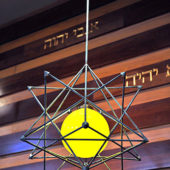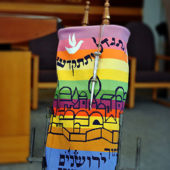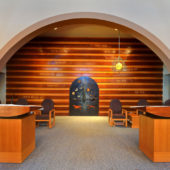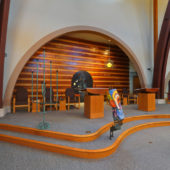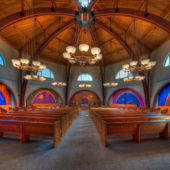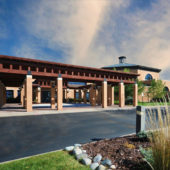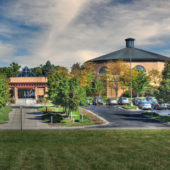Opening services at its first location were attended by more than 1,000 people shortly before the Great Depression yet construction began on a new synagogue only a week after the US entered World War II.
Shortly after Omaha’s founding in 1856 the city’s first Jews settled there. Mostly from Eastern Europe and Russia, they were primarily merchants and businessmen. From the beginning, even though the community was small, leaders of Orthodox Judaism and Reform Judaism worked to create strong congregations. Omaha’s first Jewish congregation was formed in 1871. A cemetery was established and burial society founded quickly thereafter. In 1884 the first synagogue in Omaha was dedicated.
Eastern European and Russian immigrants arrived in the US in four waves of immigration throughout the late 19th and early 20th centuries. The census records indicate that in 1890 there were 1,035 Jews living in Omaha. They were active in working class politics, particularly during the 1920s and 1930s. Others established themselves as merchants and businessmen. The Jewish community supported philanthropy and founded important cultural and charitable institutions. The renowned Jewish feminist author Tillie Olsen was born to socialist parents in Omaha. When she was young she worked in meatpacking plants and organized unions. The Jewish youth organization Aleph Zadik Aleph, was also founded by immigrants in Omaha.
Historically, Omaha has served as a landing point for immigrants from which they can migrate on to other cities. In the early 20th century a Hungarian conservative congregation arose. The 1930 census showed 2,034 Jews in Omaha, many of whom were first generation immigrants, having fled religious persecution in the Russian Empire. Today, many Jewish families have lived in Omaha for four generations, following the expansion of the city to the west. The residential areas and synagogues have moved from Downtown Omaha to the Near North Side and to the West Omaha suburbs, particularly the important North 24th Street corridor. In the late 1960s, many Jewish businesses left North Omaha after they were targeted and destroyed in the urban riots. Most of the residents had already gradually moved to West Omaha and other neighborhoods. Since 1980, new Jewish immigrants from Russia and Eastern Europe have settled in the city.
The Jewish Press, which is still in weekly publication, was founded in 1920. Omaha is the smallest community in the United States that is able to produce a weekly Jewish publication. In 1924, Jewish country club opened in Omaha, in response to its members having been excluded from other country clubs in town. Warren Buffett was one of the first non-Jewish members of the Jewish country club in the 1980s, in order to promote anti-discrimination.
The congregation which eventually became Beth El, purchased land for a cemetery in 1927. They began holding services at the Jewish Community Center in 1929, naming themselves the Beth El Congregation in 1935. During Hanukkah of 1941, they dedicated their first synagogue (with over 1,000 people in attendance at its opening) and fifty years later, after continual, ongoing growth, Beth El proudly dedicated a second new synagogue in 1991, in an area of town where most of its congregants had eventually moved. Today, Beth El Synagogue is the Conservative home of Judaism for approximately 550 families. The services are predominantly in Hebrew.
The synagogue seats 900 people and was designed by Notter Finegold and Alexander Inc. of Boston. The complex is comprised of a chapel; spacious social hall for wedding dinners, Bar/Bat Mitzvah parties and other simchas; offices; and a large kitchen. In 1996 a building was added for a school with eight classrooms and offices. The building complex is of tan brick in a modern design, offset by black roofing, set on beautifully landscaped grounds. The main sanctuary is octagonal with large, arched windows. Inside wood beams soar from the side walls meeting in circle above the center of the sanctuary. Semi-circular clerestory windows set high in the walls encircle the sanctuary, below which are large arched insets, colorfully draped with bright artwork.
The bimah is on a curved platform raised three steps above the main floor level. The Aron Kodesh is comprised of the semi-circular wall inset featuring alternating stripes of wood, medium and tawny colored, with Hebrew words etched into the darker colored wood. In the center, the doors of the Aron Kodesh are inset. They are arched and in black, beautifully decorated. The tivah (reader’s desk) rests two steps down from the bimah carved from tawny wood. Eight large chandeliers drop from the ceiling. Wood benches with gray upholstered seats complement the gray carpeting.


